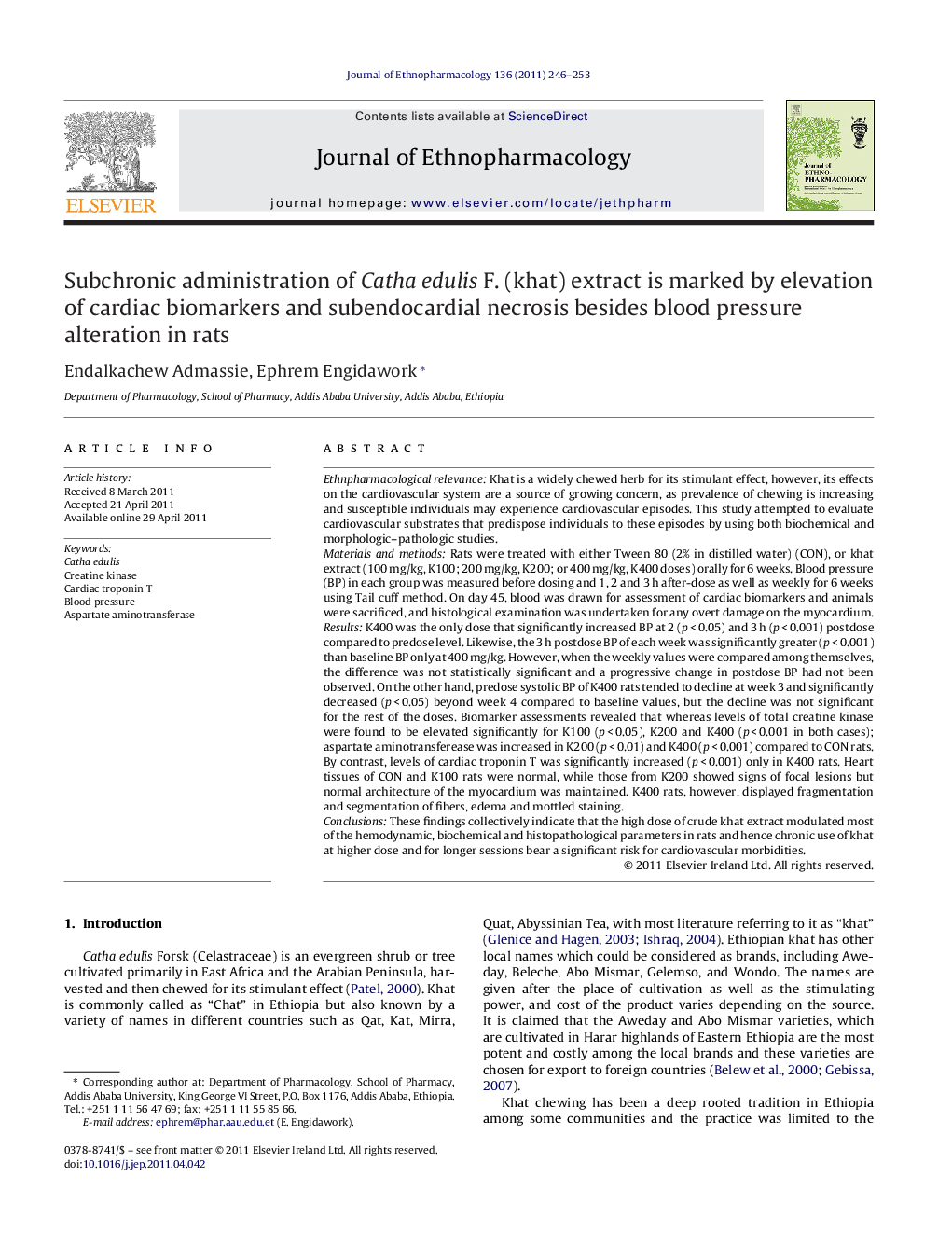| کد مقاله | کد نشریه | سال انتشار | مقاله انگلیسی | نسخه تمام متن |
|---|---|---|---|---|
| 2545727 | 1123995 | 2011 | 8 صفحه PDF | دانلود رایگان |

Ethnpharmacological relevanceKhat is a widely chewed herb for its stimulant effect, however, its effects on the cardiovascular system are a source of growing concern, as prevalence of chewing is increasing and susceptible individuals may experience cardiovascular episodes. This study attempted to evaluate cardiovascular substrates that predispose individuals to these episodes by using both biochemical and morphologic–pathologic studies.Materials and methodsRats were treated with either Tween 80 (2% in distilled water) (CON), or khat extract (100 mg/kg, K100; 200 mg/kg, K200; or 400 mg/kg, K400 doses) orally for 6 weeks. Blood pressure (BP) in each group was measured before dosing and 1, 2 and 3 h after-dose as well as weekly for 6 weeks using Tail cuff method. On day 45, blood was drawn for assessment of cardiac biomarkers and animals were sacrificed, and histological examination was undertaken for any overt damage on the myocardium.ResultsK400 was the only dose that significantly increased BP at 2 (p < 0.05) and 3 h (p < 0.001) postdose compared to predose level. Likewise, the 3 h postdose BP of each week was significantly greater (p < 0.001) than baseline BP only at 400 mg/kg. However, when the weekly values were compared among themselves, the difference was not statistically significant and a progressive change in postdose BP had not been observed. On the other hand, predose systolic BP of K400 rats tended to decline at week 3 and significantly decreased (p < 0.05) beyond week 4 compared to baseline values, but the decline was not significant for the rest of the doses. Biomarker assessments revealed that whereas levels of total creatine kinase were found to be elevated significantly for K100 (p < 0.05), K200 and K400 (p < 0.001 in both cases); aspartate aminotransferease was increased in K200 (p < 0.01) and K400 (p < 0.001) compared to CON rats. By contrast, levels of cardiac troponin T was significantly increased (p < 0.001) only in K400 rats. Heart tissues of CON and K100 rats were normal, while those from K200 showed signs of focal lesions but normal architecture of the myocardium was maintained. K400 rats, however, displayed fragmentation and segmentation of fibers, edema and mottled staining.ConclusionsThese findings collectively indicate that the high dose of crude khat extract modulated most of the hemodynamic, biochemical and histopathological parameters in rats and hence chronic use of khat at higher dose and for longer sessions bear a significant risk for cardiovascular morbidities.
Cardiovascular effects of Catha edulis F. (khat) were evaluated by measuring blood pressure and cardiac biomarkers as well as by performing morphological pathologic studies. High dose of khat was demonstrated to alter blood pressure, elevate cardiac troponin T and to cause subendocardial necrosis.Figure optionsDownload as PowerPoint slide
Journal: Journal of Ethnopharmacology - Volume 136, Issue 1, 14 June 2011, Pages 246–253